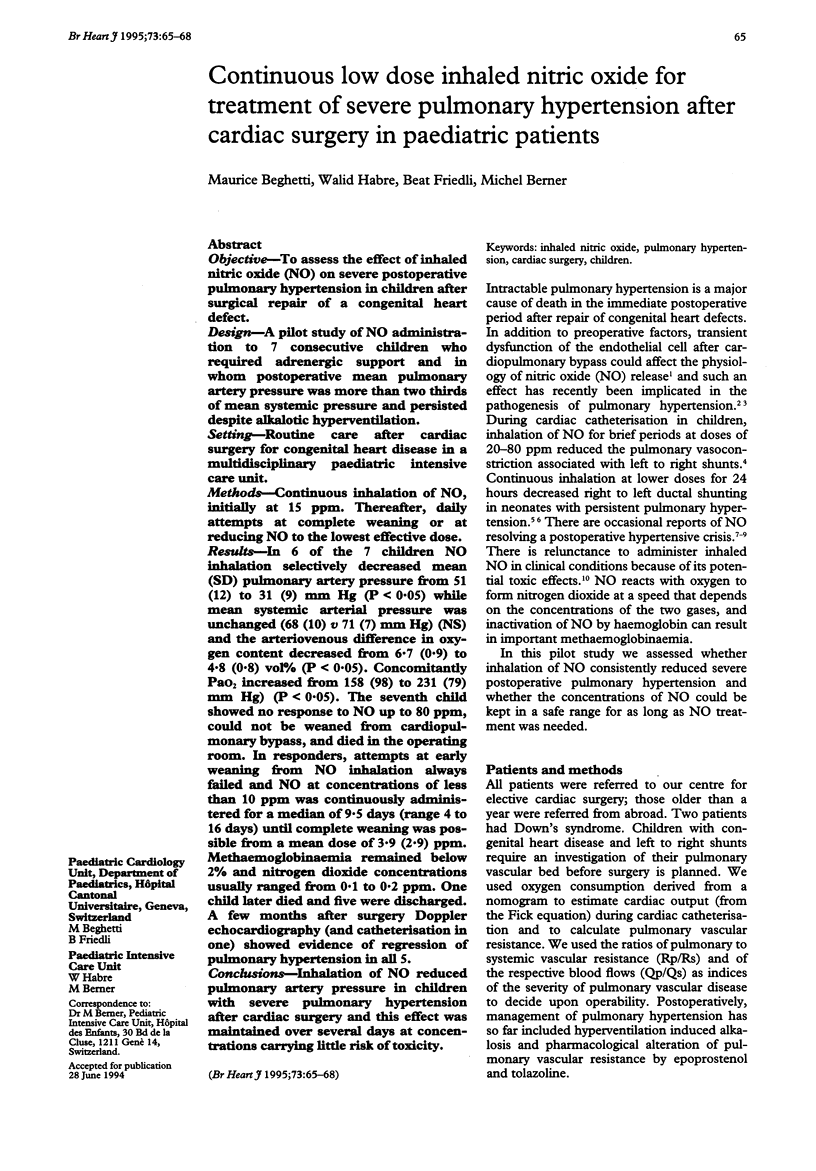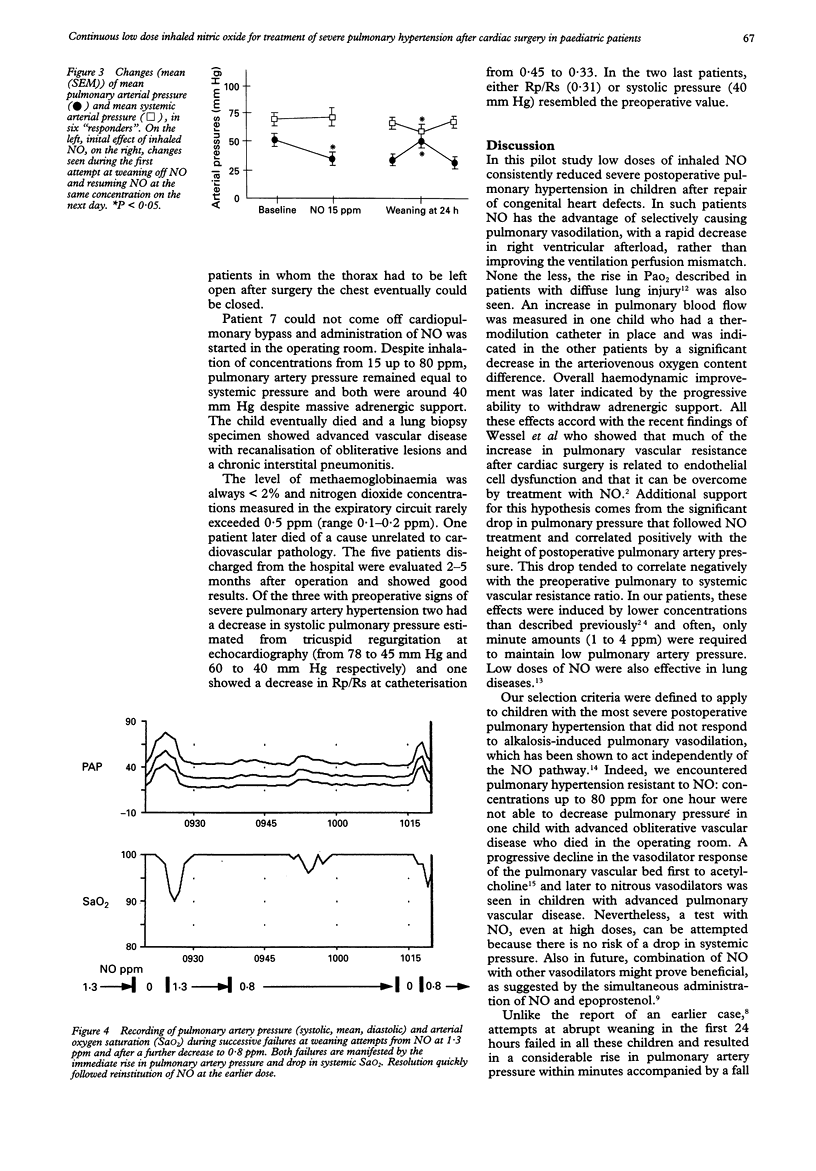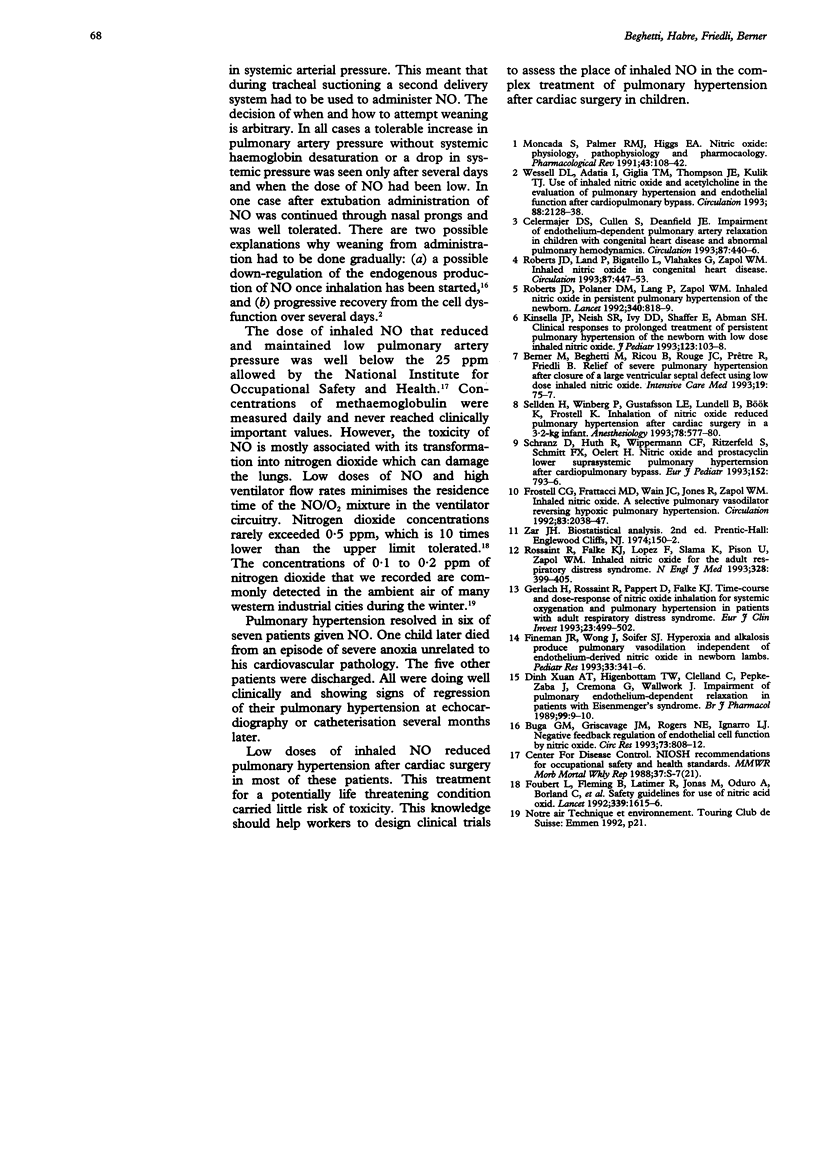Abstract
OBJECTIVE--To assess the effect of inhaled nitric oxide (NO) on severe postoperative pulmonary hypertension in children after surgical repair of a congenital heart defect. DESIGN--A pilot study of NO administration to 7 consecutive children who required adrenergic support and in whom postoperative mean pulmonary artery pressure was more than two thirds of mean systemic pressure and persisted despite alkalotic hyperventilation. SETTING--Routine care after cardiac surgery for congenital heart disease in a multidisciplinary paediatric intensive care unit. METHODS--Continuous inhalation of NO, initially at 15 ppm. Therefore, daily attempts at complete weaning or at reducing NO to the lowest effective dose. RESULTS--In 6 of the 7 children NO inhalation selectively decreased mean (SD) pulmonary artery pressure from 51 (12) to 31 (9) mm Hg (P < 0.05) while mean systemic arterial pressure was unchanged (68 (10) v 71 (7) mm Hg) (NS) and the arteriovenous difference in oxygen content decreased from 6.7 (0.9) to 4.8 (0.8) vol% (P < 0.05). Concomitantly PaO2 increased from 158 (98) to 231 (79) mm Hg) (P < 0.05). The seventh child showed no response to NO up to 80 ppm, could not be weaned from cardiopulmonary bypass, and died in the operating room. In responders, attempts at early weaning from NO inhalation always failed and NO at concentrations of less than 10 ppm was continuously administered for a median of 9.5 days (range 4 to 16 days) until complete weaning was possible from a mean dose of 3.9 (2.9) ppm. Methaemoglobinaemia remained below 2% and nitrogen dioxide concentrations usually ranged from 0.1 to 0.2 ppm. One child later died and five were discharged. A few months after surgery Doppler echocardiography (and catheterisation in one) showed evidence of regression of pulmonary hypertension in all 5. CONCLUSIONS--Inhalation of NO reduced pulmonary artery pressure in children with severe pulmonary hypertension after cardiac surgery and this effect was maintained over several days at concentrations carrying little risk of toxicity.
Full text
PDF



Selected References
These references are in PubMed. This may not be the complete list of references from this article.
- Berner M., Beghetti M., Ricou B., Rouge J. C., Prêtre R., Friedli B. Relief of severe pulmonary hypertension after closure of a large ventricular septal defect using low dose inhaled nitric oxide. Intensive Care Med. 1993;19(2):75–77. doi: 10.1007/BF01708365. [DOI] [PubMed] [Google Scholar]
- Buga G. M., Griscavage J. M., Rogers N. E., Ignarro L. J. Negative feedback regulation of endothelial cell function by nitric oxide. Circ Res. 1993 Nov;73(5):808–812. doi: 10.1161/01.res.73.5.808. [DOI] [PubMed] [Google Scholar]
- Celermajer D. S., Cullen S., Deanfield J. E. Impairment of endothelium-dependent pulmonary artery relaxation in children with congenital heart disease and abnormal pulmonary hemodynamics. Circulation. 1993 Feb;87(2):440–446. doi: 10.1161/01.cir.87.2.440. [DOI] [PubMed] [Google Scholar]
- Dinh Xuan A. T., Higenbottam T. W., Clelland C., Pepke-Zaba J., Cremona G., Wallwork J. Impairment of pulmonary endothelium-dependent relaxation in patients with Eisenmenger's syndrome. Br J Pharmacol. 1990 Jan;99(1):9–10. doi: 10.1111/j.1476-5381.1990.tb14643.x. [DOI] [PMC free article] [PubMed] [Google Scholar]
- Fineman J. R., Wong J., Soifer S. J. Hyperoxia and alkalosis produce pulmonary vasodilation independent of endothelium-derived nitric oxide in newborn lambs. Pediatr Res. 1993 Apr;33(4 Pt 1):341–346. doi: 10.1203/00006450-199304000-00007. [DOI] [PubMed] [Google Scholar]
- Foubert L., Fleming B., Latimer R., Jonas M., Oduro A., Borland C., Higenbottam T. Safety guidelines for use of nitric oxide. Lancet. 1992 Jun 27;339(8809):1615–1616. doi: 10.1016/0140-6736(92)91886-d. [DOI] [PubMed] [Google Scholar]
- Frostell C., Fratacci M. D., Wain J. C., Jones R., Zapol W. M. Inhaled nitric oxide. A selective pulmonary vasodilator reversing hypoxic pulmonary vasoconstriction. Circulation. 1991 Jun;83(6):2038–2047. doi: 10.1161/01.cir.83.6.2038. [DOI] [PubMed] [Google Scholar]
- Gerlach H., Rossaint R., Pappert D., Falke K. J. Time-course and dose-response of nitric oxide inhalation for systemic oxygenation and pulmonary hypertension in patients with adult respiratory distress syndrome. Eur J Clin Invest. 1993 Aug;23(8):499–502. doi: 10.1111/j.1365-2362.1993.tb00797.x. [DOI] [PubMed] [Google Scholar]
- Kinsella J. P., Neish S. R., Ivy D. D., Shaffer E., Abman S. H. Clinical responses to prolonged treatment of persistent pulmonary hypertension of the newborn with low doses of inhaled nitric oxide. J Pediatr. 1993 Jul;123(1):103–108. doi: 10.1016/s0022-3476(05)81551-3. [DOI] [PubMed] [Google Scholar]
- Roberts J. D., Jr, Lang P., Bigatello L. M., Vlahakes G. J., Zapol W. M. Inhaled nitric oxide in congenital heart disease. Circulation. 1993 Feb;87(2):447–453. doi: 10.1161/01.cir.87.2.447. [DOI] [PubMed] [Google Scholar]
- Roberts J. D., Polaner D. M., Lang P., Zapol W. M. Inhaled nitric oxide in persistent pulmonary hypertension of the newborn. Lancet. 1992 Oct 3;340(8823):818–819. doi: 10.1016/0140-6736(92)92686-a. [DOI] [PubMed] [Google Scholar]
- Rossaint R., Falke K. J., López F., Slama K., Pison U., Zapol W. M. Inhaled nitric oxide for the adult respiratory distress syndrome. N Engl J Med. 1993 Feb 11;328(6):399–405. doi: 10.1056/NEJM199302113280605. [DOI] [PubMed] [Google Scholar]
- Schranz D., Huth R., Wippermann C. F., Ritzerfeld S., Schmitt F. X., Oelert H. Nitric oxide and prostacyclin lower suprasystemic pulmonary hypertension after cardiopulmonary bypass. Eur J Pediatr. 1993 Oct;152(10):793–796. doi: 10.1007/BF02073372. [DOI] [PubMed] [Google Scholar]
- Selldén H., Winberg P., Gustafsson L. E., Lundell B., Bök K., Frostell C. G. Inhalation of nitric oxide reduced pulmonary hypertension after cardiac surgery in a 3.2-kg infant. Anesthesiology. 1993 Mar;78(3):577–580. doi: 10.1097/00000542-199303000-00021. [DOI] [PubMed] [Google Scholar]
- Wessel D. L., Adatia I., Giglia T. M., Thompson J. E., Kulik T. J. Use of inhaled nitric oxide and acetylcholine in the evaluation of pulmonary hypertension and endothelial function after cardiopulmonary bypass. Circulation. 1993 Nov;88(5 Pt 1):2128–2138. doi: 10.1161/01.cir.88.5.2128. [DOI] [PubMed] [Google Scholar]


